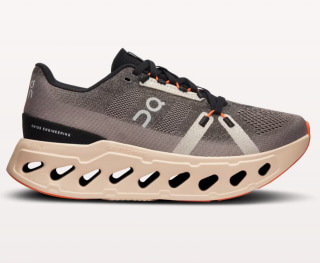I bought my first pair of On running sneakers in 2019 purely out of curiosity. I lived in Chicago at the time, and all the runners that passed me while I was jogging along Lake Michigan wore the brand’s shoes. I wondered what I was missing out on, so I got a pair of On’s Cloudflyer sneakers. Honestly, I didn’t love them. They weren’t cushioned enough for my liking, and the feel of the ridged outsole, which resembles an egg carton, threw me off. I didn’t think much of On after that — until I slipped my feet into the brand’s Cloudeclipse running shoes.
On sent me it’s Cloudeclipse sneakers to test when they launched in November 2023. Immediately upon opening the box, I could tell they were drastically different from the shoes I tried four years prior. The Cloudeclipse is a tall, highly cushioned shoe, and unlike many of the brand’s models, it has a smooth outsole. The first time I wore them, I was pleasantly surprised by how comfortable they kept my feet, how much pressure they took off my joints and how supported I felt mile after mile.
I’ve been running in the Cloudeclipse for the past nine months and despite having over a dozen pairs of sneakers in my closet, and rotating between two to three different pairs a week to test new models, I constantly come back to the Cloudeclipse. They support me regardless of whether I’m running indoors or outdoors, and I now travel with them because they’re so reliable. If you’re in the market for a new pair of running shoes, these might be exactly what you’re looking for.
SKIP AHEAD How I tested the On Cloudeclipse | My experience with the On Cloudeclipse | Who are the On Cloudeclipse best for? | Why trust NBC Select?
The Cloudeclipse ($180) is one of On’s maximum cushioning running sneakers. It’s designed with a thick layer of foam in its midsole, which not only makes it comfortable, but also helps reduce how much impact you feel when your feet hit the ground, according to the brand.
The shoe’s tall midsole gives it some height, and its tongue is connected to its breathable, mesh upper to keep it in place while you’re running. There are also rubber pads on the outsole that help your feet grip the ground in wet conditions. The sneakers come with shoelaces you need to tie up rather than elastic laces that you slip your foot under, which some of On’s other running shoes come with.
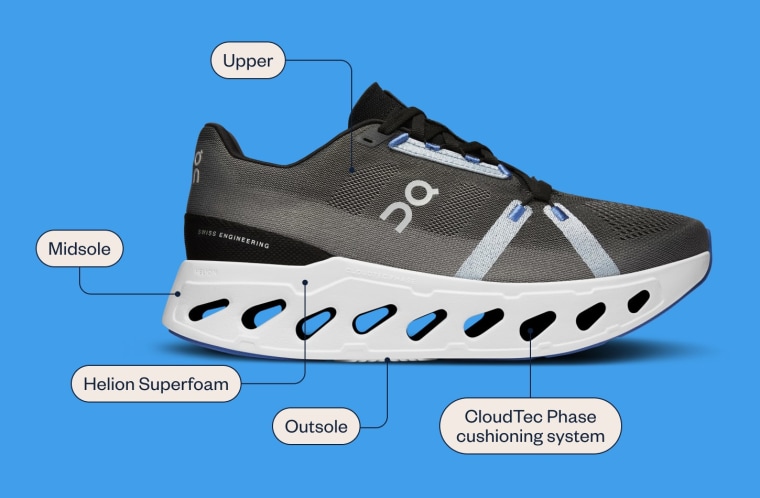
There are three main features that define the look and feel of this shoe, all of which are proprietary to On sneakers:
- Helion superfoam refers to the cushioning the sneaker is made with. It has some rigid, stable sections and some soft, flexible sections. The lightweight foam sits between the upper and outsole of the sneaker, creating a thick barrier between your feet and the ground.
- CloudTec Phase is the sneaker’s cushioning system, and it’s what gives the midsole its Swiss cheese-like appearance. Its oval-shaped pods (the holes you can see in the foam) collapse as your feet hit the ground, making for soft landings, and expand as you push-off the ground to give each step a boost. CloudTech Phase is an iteration of On’s original CloudTech cushioning system, which the brand has used since its inception.
- The Speedboard is the plastic X-shaped plate in the shoe’s midsole. You can see it if you flip the sneaker over and look at the bottom. The plate bends and flexes as you run, pushing you forward to make you faster while stabilizing you, according to On.
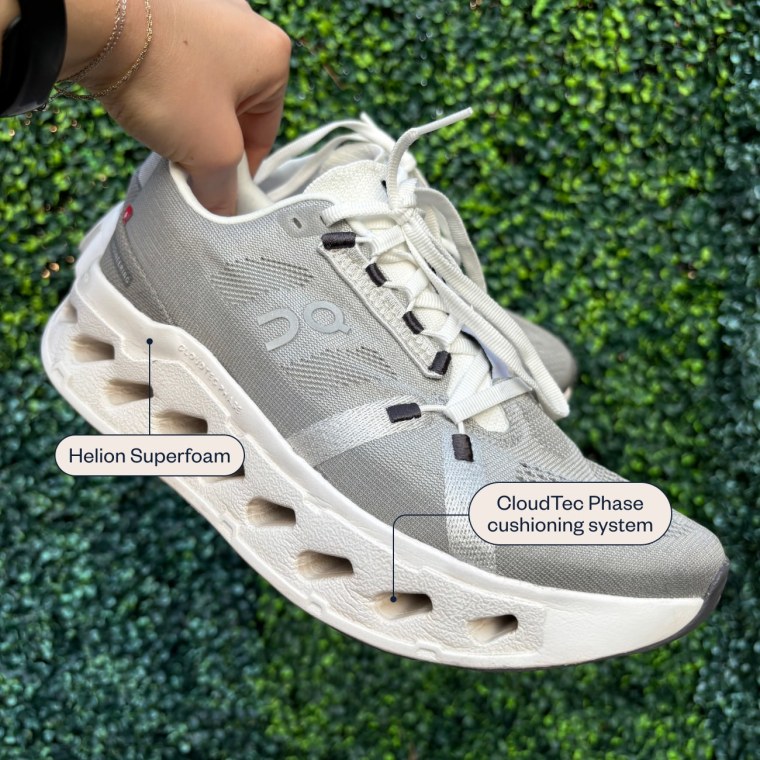
Additionally, the Cloudeclipse sneaker has a six millimeter heel drop — that means your heel sits six millimeters higher than your forefoot when you’re wearing these sneakers. It also indicates that the shoe’s cushioning is pretty evenly distributed. Six millimeters is a lower heel drop compared to some of On’s other running sneakers, like the Cloudsurfer (10mm) and Cloudflyer (9mm). Shoes with a lower heel drop tend to place more load on your ankles and are generally better for runners who strike the ground with their midfoot or forefoot first, according to On.
Material: polyester mesh, recycled fabrics | Weight: about 8.5 oz. (women’s), about 10 oz. (men’s) | Sizes: 5-11 (women’s), 7-14 (men’s) including half sizes | Colors: Alloy/White (gray with white), Rock/Lime (gray with green), Fade/Sand (black and tan)
How I tested the On Cloudeclipse
I’ve been running in these sneakers for about nine months since they launched in November 2023. (The brand sent me a courtesy sample for testing.) I typically run between 28 and 35 miles a week, both inside on a treadmill and outside on pavement. I don’t wear the same sneakers to run every day, however. On average, I rotate between two or three pairs a week from brands like Nike, Brooks, Saucony, Hoka and New Balance, so I typically log about 10 miles a week in the Cloudeclipse. In addition to the Cloudeclipse, I’ve also tested On’s Cloudflyer, Cloudsurfer and Cloudmonster running sneakers, plus the Cloudeasy walking sneakers, so I’m familiar with the look and feel of the brand’s shoes.
My experience with On’s Cloudeclipse running sneakers
What I like
Highly cushioned, impact-absorbing midsole
When I first started running about a decade ago, I never paid attention to how much cushioning my sneakers had. I focused on choosing a comfortable pair with a wide toe box so I didn’t lose my toenails while training. Now, cushioning is a top priority for me. Years of running, and years of dancing before that, makes me prone to occasional shin splints, hip pain, achy knees and tight IT bands, so I can’t run in sneakers that are on the flatter side. They put too much pressure on my joints and I quickly feel the impact of my feet forcefully, repetitively hitting the ground.
Because of that, I gravitate toward highly cushioned running sneakers, but I’m picky. I don’t like shoes that are extra soft because they make me feel like I’m sinking into the midsole. I also don’t like shoes that have extra firm cushioning because they hurt my feet after a couple miles.
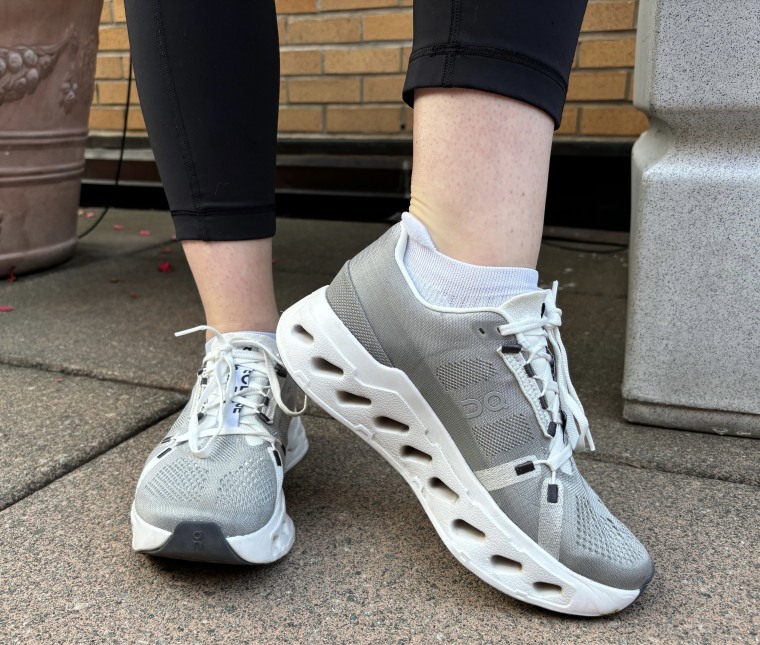
The Cloudeclipse’s cushioning system and thick layer of foam give me the exact impact-absorbing, supportive feel I look for while running. The pods in the midsole compress as my feet hit the ground to soften my landings, which helps make my steps feel light and gentle instead of hard and heavy. Then, as I move through a stride and begin to lift off again, the pods expand to push me forward. This makes my stride bouncy, but controlled enough that I can easily maintain a steady pace across long distances.
Meanwhile, the sneaker’s thick layer of evenly distributed foam creates a supportive barrier between the ground and the rest of my body. It effectively absorbs impact as I’m running so I don’t feel pressure in my joints, which prevents pain from building up in my knees and hips over time, especially on the treadmill. Typically during the winter months, when I run on the treadmill, I almost always end up with knee and hip pain. But this past winter I didn’t experience any of that pain, and my sneakers were the only thing I changed about my running routine compared to last year.
The Cloudeclipse’s foam also strikes a balance between soft and firm, giving my feet a comfortable place to rest without making me feel like I’m sinking into the midsole. If you’ve worn On’s Cloudmonster or Cloudsurfer sneakers, the Cloudeclipse land somewhere in the middle in terms of their feel — they’re not as firm as the Cloudmonster, and not as soft as the Cloudsurfer, in my experience.
Lightweight feel
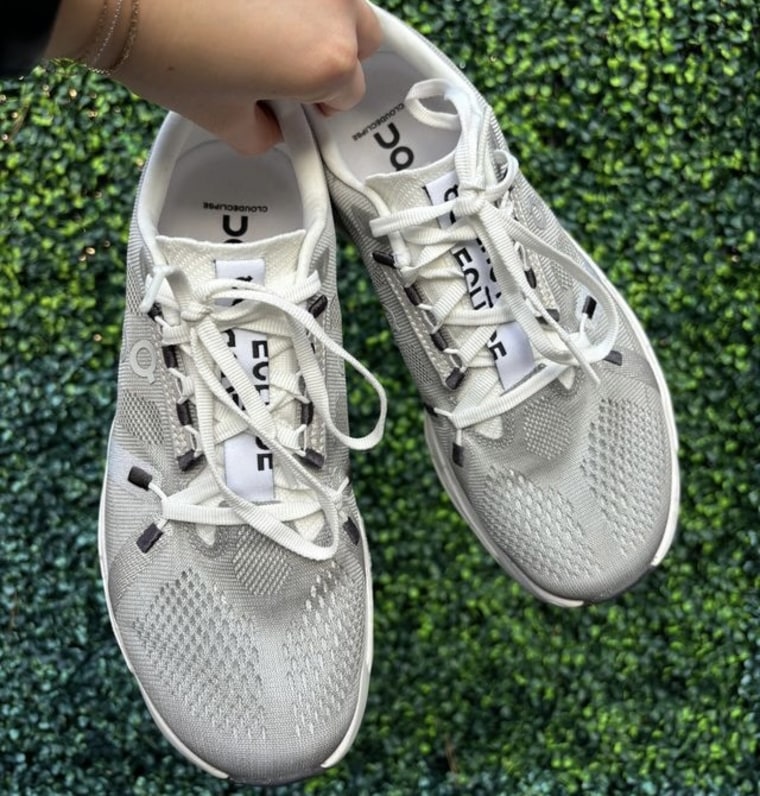
While I prefer highly cushioned running sneakers, wearing them usually forces me to sacrifice speed to some degree. The more cushioning a sneaker has, the heavier it tends to be, which can weigh me down and make it harder for me to quickly put one foot in front of the other. That was my main concern when I first saw a picture of the Cloudeclipse. Its midsole is noticeably thick, more so compared to other sneakers I frequently run in, like the Brooks Ghost Max 2 and Saucony Hurricane 24. Because of this, I expected the Cloudeclipse to be particularly weighty.
To my surprise, they are the lightest highly cushioned pair I have in my closet, both on paper and in practice. My sneakers weigh about 8.5 ounces, which, as a point of reference, is a little more than the weight of a mini Poland Spring water bottle. In comparison, the Brooks Ghost Max 2 weighs 10.8 ounces and the Saucony Hurricane 24 weighs 9.8 ounces.
Because they’re so lightweight, they don’t negatively impact my speed whatsoever. They actually make me feel like I can run faster for a longer period of time since I’m less tempted to drag my feet when my legs start to get tired.
Effective propulsion
I don’t want to work extra hard to put one foot in front of the other while I’m running, so I typically look for sneakers with a curved, rocker-shaped outsole. It encourages my feet to continuously roll through a stride every time I hit the ground and makes my heel-to-toe transitions smooth. Together, these factors prevent me from having to exert a lot of energy while running to maintain momentum.
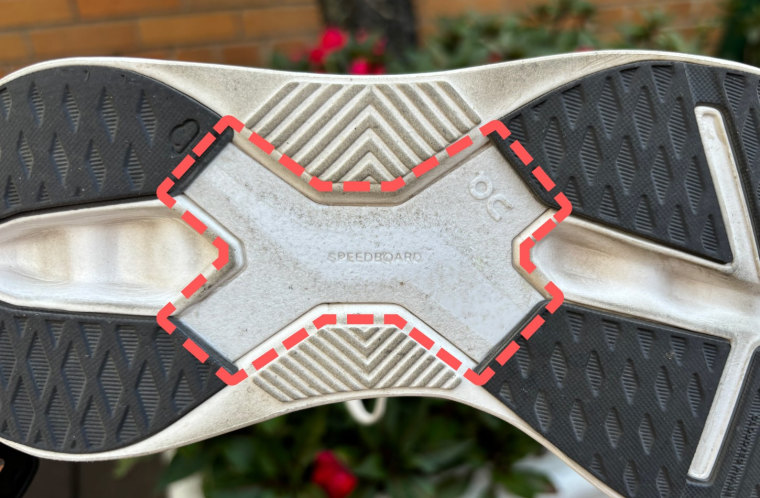
The Cloudeclipe’s curved outsole is complimented by its X-shaped midsole plate, which bends with my feet as I run, offering flexibility that I haven’t found with rigid carbon plates in shoes like the Hoka Skyward X and the Brooks Hyperion Elite 4. The plate also stabilizes me when I land so I don’t feel off balance, and launches me forward as I take off to give each new step a boost.
Smooth outsole
Many of On’s sneakers have a scalloped outsole due to the positioning of their CloudTech cushioning system. I didn’t think this would impact my runs much when I tried my first pair of the brand’s shoes in 2019, but it ended up being more of an adjustment than I expected.
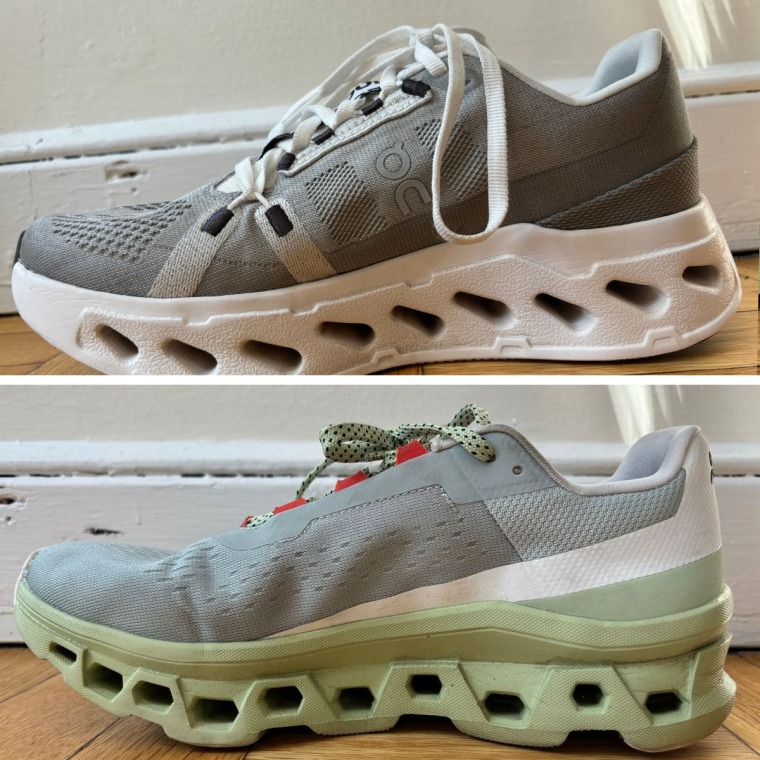
The scalloped outsole created an uneven sensation when my feet hit the ground, so I felt like I couldn’t find my balance and had to work extra hard to keep up my momentum. If I ran on trails, rocks and little twigs would often get stuck in the scalloped outsole, which I found annoying.
The Cloudeclipse’s outsole is smooth on the bottom because its cushioning system is positioned higher up in the midsole. That means I avoid all the issues I encountered with other On models’ scalloped outsole, making my overall running experience more pleasant.
Potential drawbacks to keep in mind
Tall height
Because this sneaker has such a thick midsole, it lifts me off the ground by about two inches. I’m used to running in tall, highly cushioned sneakers since I’ve been doing so for years, but if you’re new to it, you may find the overall height of this shoe to be destabilizing at first. My advice is to start slow — instead of running at your race pace the moment you put these sneakers on, go for a slower jog at first to get used to the base’s height. Also make sure you tie the shoes tightly enough. When I don’t, I feel more unstable, especially in my ankles.
Strictly for running
Some running sneakers can double as walking shoes, but I don’t find that to be the case with the Cloudeclipse. The Speedplate also isn’t as responsive when I’m walking, which doesn’t make the shoe as flexible as I’d like. I prefer a less structured shoe that’s lower in height and made with a more cushy foam when I’m walking, like the New Balance Fresh Foam X 1080v13. Because of this, I only wear Cloudeclipse to run, but everyone’s preferences are different, so you may feel otherwise.
Who are the On Cloudeclipse running sneakers best for?
If you’re looking for a highly cushioned shoe that effectively absorbs shock and propels you forward for miles, then On’s Cloudeclipse are likely a good fit. It’s intentionally built to protect runners’ bodies from the repetitive pounding motion of their feet hitting the ground, and as someone with frequent knee and hip pain, that’s exactly what I look for while shopping.
I’ve been running for over a decade, so I can safely say that they’re suitable for veteran runners. But I think they’re a great option for beginners too, especially those who’ve previously enjoyed wearing highly cushioned walking shoes.
At $180, the Cloudeclipse is pricey, but it doesn’t cost significantly more than some of On’s other highly cushioned models, like the Cloudmonster ($170) and Cloudsurfer ($160). It’s also around the same price point as its competitors’ max-cushion sneakers, including the Brooks Ghost Max 2 ($150), Saucony Hurricane 24 ($160) and Hoka Bondi 8 ($165).
Why trust NBC Select?
I am an associate updates editor at NBC Select who writes about fitness apparel, including training shoes, women’s walking shoes and sports bras. I also frequently test and review running sneakers, like the Lululemon Chargefeel 2 and Brooks Ghost Max. I’ve been a runner for about 10 years and have tried five pairs of On sneakers since 2019. For this article, I tested On’s Cloudeclipse shoe for nine months, starting in November 2023, which is when it launched.
Catch up on NBC Select’s in-depth coverage of personal finance, tech and tools, wellness and more, and follow us on Facebook, Instagram, Twitter and TikTok to stay up to date.

